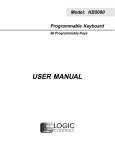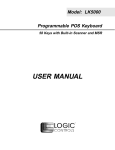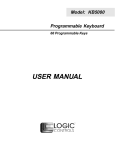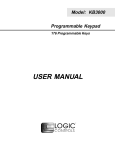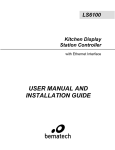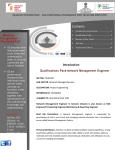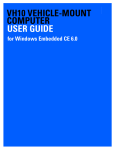Download KB1700 User Manual
Transcript
Model: KB1700 Programmable Keypad 17 Programmable Keys USER MANUAL NOTICE The manufacturer of the POS programmable keypad makes no representations or warranties, either expressed or implied, by or with respect to anything in this manual, and shall not be liable for any implied warranties of fitness for a particular purpose or for any indirect, special or consequential damages. Information in this document is subject to change without notice and does not represent a commitment on the part of the manufacturer. FCC NOTICE This device complies with Part 15 of FCC Rules. Operations is subject to the following two conditions: (1) this device may not cause harmful interference. and (2) this device must accept any interference received, including interference that may cause undesired operation. i TABLE OF CONTENTS FEATURES ............................................................................... 1 CARTON CONTENTS .............................................................. 2 HARDWARE CONNECTIONS ................................................. 3 FUNCTIONAL TEST ................................................................ 5 UTILITY DISK CONTENTS ...................................................... 7 INSTALLING THE KB17.EXE UTILITY PROGRAM .................. 8 STARTING THE KB17.EXE PROGRAM ................................... 8 PROGRAMMING THE KB1700 KEYPAD .................................. 10 ADVANCED PROGRAMMING ................................................. 12 SPECIAL FEATURES OF THE KB1700 .................................... 13 INTER-STRING DELAY ............................................ 13 MULTI-LEVEL DEFINITION ...................................... 14 SELF PROGRAMMING ............................................ 16 SPECIAL CONFIGURATIONS ................................................. 17 DATA TRANSFER MENU ......................................................... 19 PINOUTS ................................................................................. 21 SPECIFICATIONS .................................................................... 22 ii FEATURES • Fully downward compatible with the IBM Bump Bar • All 17 keys are programmable, up to 119 characters per key • Keypad I/O ports allow daisy-chaining of input devices • Programmable inter-string delay • Stainless steel dome disk switches • Standard computer 101 keyboard output data format • Output data set includes all alphanumeric, controls, and function codes • Optional international output codes (Alt-Number) • True keyboard wedge function, operates with or without computer keypad • Internal beeper • No programming accessory kit, TSR program, or battery required • Available with RS232C output 1 CARTON CONTENTS KB1700 1. 2. 3. 4. 5. 6. Keypad, Model KB1700 Interface cable to computer Interface cable to 101 keyboard Utility software disk Legend label sheet User’s manual 2 HARDWARE CONNECTIONS The KB1700 can be connected to an IBM101 PC, XT, AT or clone computer, PS/2 computer, or computer terminal. The following diagram shows how the KB1700 connects to the computer and standard keypad or other keypad peripheral (magnetic stripe reader, scanner, etc.). NOTE: Before making any connections it is always advisable to turn off the computer. A. Connecting the KB1700 to an IBM101 PC, XT, AT, or clone computer’s keypad port: 1. Use the computer interface cable. Plug the AT or PS/2 Male connector plugs into the compter. Connect the RJ11 connector into the “To Computer” connector on the KB1700. 2. Connect the keypad interface cable to the standard keyboard. The AT or PS/2 Female connector plugs into the standard keyboard. The RJ11 connector plugs into the “To Keyboard” connector on the back of the KB1700. 3 FUNCTIONAL TEST For testing purposes, your KB1700 keypad was pre-programmed with a template called LC.tpl. The following simple steps will verify that the KB1700 is in good working condition: 1. Follow the Hardware Connections procedure described earlier in this manual to connect the KB1700 to your computer. 2. Turn on your computer. 3. At the DOS prompt, press the upper left key of the keypad. 4. The keypad is working correctly when the words “LOGIC CONTROLS PROGRAMMABLE KEYPAD, MODEL KB1700” appears on the monitor. To verify if the other keys are working simply press each key and verify that the information displayed on the monitor matches the template shown at the end of this section. 4 5 UTILITY DISK CONTENTS All KB1700 keypads come with a utility software disk. This disk contains several important files: KB17.EXE - Use this utility with or without the keypad being attached. It is used to program the keypad. For a complete description of how this program works see the section “Programming the KB1700 keypad”. LC.TPL - This template was pre-programmed into the keypad and matches the legend shown on the previous page. If you have any questions on how to program a particular key you can refer back to this template to see how it was originally programmed. MANUAL.PDF- KB1700 manual INSTALLING THE KB17.EXE UTILITY PROGRAM The first step in using the KB17.EXE utility program is to copy the program to your hard drive. 1. Insert the KB1700 utility software into drive A or B of the computer. 2. Type MD KB17 at the “C>“ prompt to make a directory named KB17. 3. Type CD KB17 to make the KB17 directory active. 4. Type COPY A:*.* If the disk was inserted into drive A then all files will be copied into the hard drive’s directory (KB17). If drive B is used then you must type COPY B:*.* 6 STARTING THE KB17.EXE PROGRAM This program can be used with or without the keypad being attached to the computer. To start the program type KB17 at the KB17 DOS prompt and press ENTER. When the 101 keyboard is used by itself, the program will acknowledge that no keypad is attached by displaying a “No POS keypad found” message. To continue using the program you must select one of the choices shown. If the keypad is attached, the program will automatically select the correct programming graphics screen for you. 7 F 2 F ile F 5 R e c o v e r F 8 S c a n -c o d e m o d e F 1 0 F 3 C o n fig u r e F 6 F 9 A s c ii- c o d e m o d e F 7 C le a r Q u it S y m b o l / H e x S h ift + A lt + D T im e D e la y A lt + A S h ift F u n c tio n A lt + S S e p a ra to r A lt + C C a p s L o c k U p L e ft R ig h t D o w n 8 K 0 2 K 0 1 K 0 7 K 0 1 K 0 8 K 0 9 K 1 0 K 1 1 K 0 5 K 0 4 K 0 3 K 1 2 K 1 3 K 1 4 K 1 5 A S C II M o d e L O G IC C O N T R O L S , P R O G R A M M A B L E K E Y P A D M O D E L K B 1 7 0 0 K 0 6 K 1 6 K 1 7 PROGRAMMING THE KB1700 KEYPAD The following procedure will show you how to program your KB1700 with standard (keyboard) alphanumeric characters. The keypad can be programmed with either ASCII or Scan code information. The default mode is the ASCII code mode. The following procedure assumes both a KB1700 keypad and a 101 keyboard are attached. NOTE: To run this program you must exit windows completely. Do not shell out from Windows. 1. With the correct programming graphics present. Select the cell you want to program by using the arrow keys on the 101 keyboard. The Up and Down arrows will select the row while the Shift and either the Right or Left arrow key will select the column. 2. Enter your programming text via the 101 keyboard. Continue programming until all the keys are programmed. It is not necessary to program all the keys for the KB1700 to function properly. The maximum number of alphanumeric characters that can be programmed for any one key is only limited by total memory left. NOTE: The maximum number of alphanumeric characters that can be programmed per standard keypad is 1856. DATA TRANSFER MENU Dos shell File list (*.tpl) Load file from disk Read from keypad Save file to disk Write to keypad Press ESC to Quit 3. Press F2 to call up the Data Transfer Menu. There will be several choices to choose from. 4. Type W to write the programmed data into the KB1700’s non volatile memory. A “Writing Data” screen will open showing the percentage of memory written. It will take approximately 7 seconds 9 to copy the data into the keypad. 5. Type S to save the programmed data into the KB17 directory. You can select up to an 8 character name. It will be saved with a .TPL extension. 6. Press ESC to terminate the Data Transfer Menu. 7. Press F10 followed by Y to exit the utility program. 8. To verify that your program has been successfully installed, simply press any programmed key. The information stored in that key will appear on the monitor. 9. The next time you want to install the legend you just created simple press F2 to call up the Data Transfer Menu and then press L to open the Load window. 10. Enter the name of the file in the legend window with its proper extension (.TPL) and press ENTER. The legend will now show on your monitor. 10 ADVANCED PROGRAMMING The KB1700 POS keypad can be programmed with all special control and function keys such as the Shift, Ctrl, Alt, F1 through F12, and the up/down/ left/right arrow keys. The procedure to program these special keys is shown below: 1. Start the KB17 utility program. 2. Select the cell to be programmed. Press F8 to enter the scancode mode. The “code type” information changes from ASCII to SCAN. NOTE: The scan-code mode will only be active for this cell. You must select F8 for each cell you want to program with scan-code information. 3. 4. Under the scan-code mode, each alphanumeric character is enclosed in parenthesis. For special function or control keys, press ESC (three vertical bars will be present) followed by the special function or control key you want to program. For example, to program the INS (insert) key, press ESC and then the INS key on the 101 keyboard. To program the ESC key, simply press the ESC key twice. Special function and control keys will not appear inside parenthesis. The three vertical bars will disappear once the special function key is depressed. You may return to the start-up graphic screen (short menu) by pressing Ctrl-Alt-F4 again. NOTES: 1) Special function keys require ESC as the leading code. In the scan-code mode, you can view the symbol of the special key or the hex code equivalent of the special key. To view, simply press F7 to toggle between symbol and hex modes. 2) Once a special function key (shift, ctrl, alt, etc.) is programmed it may be necessary to un-select the function. To do so, press in sequence ESC, f (lower case F), 0 (zero), ESC, followed by the special function key (shift, ctrl alt, etc.) 3) Any given programmable location may be toggled between scan-code mode and ASCIIcode mode. Pressing the F8 key on the keyboard will change the cell’s programming mode to scan-code mode. Pressing F9 on the keyboard will change the cell’s programming mode to ASCII-code mode. Changing modes in a cell that has been previously programmed will erase all the information in that cell. 4) To enter hex scan-codes directly, press ESC followed by the 2-digit hex number. For example, to program the CTRL key press ESC followed by 1D. The KB17 program will add the leading zero 11 SPECIAL FEATURES OF THE KB1700 Besides being able to program all the keys of an IBM101 keyboard, the KB1700 has also incorporated three state-of-the-art features which will add flexibility and functionality to the keypad. INTER-STRING DELAY This feature allows for a time delay(s) to be installed after a character(s) has been inserted into a cell. To use this feature follow the steps below: 1. Enter the character(s) which will precede the delay. For example, ABC. 2. Depress and hold the ALT key while pressing the letter D. A time delay screen will open asking for the amount of delay you require (up to 240 seconds). Select the appropriate delay and press ENTER. A square pixel will appear on the programming line immediately following the last character typed. 3. Type the next character(s), DEF. You can use more than one delay per cell and each delay time can be different. 4. Save the template and then write the template to the keypad. 5. Exit the KB17 program by pressing F10 followed by the letter Y. 6. Press the location key where the time delay character has been stored. The monitor will display ABC immediately. After the delay time you entered for this key has expired, DEF will be displayed on the monitor and the cursor will be present at the prompt. 12 MULTI-LEVEL DEFINITION This feature can increase the apparent number of programmable keys by allowing you to program different levels into any cell. For every different level you program you must select another key to be a “SHIFT LEVEL” key. Programming is accomplished in the normal manner. After programming the base level a separator bar must be entered to separate the base level from the second level. You can program more than two levels per cell. For example, if you needed to program small coffee, medium coffee, and large coffee into one cell follow the procedure outlined below: 1. Select a blank cell and enter the most common coffee first (medium coffee). Mark the legend sheet for this cell COFFEE. 2. Enter the separator bar by depressing and holding the ALT key and pressing the letter S. A solid line will appear on the programming line immediately following the last character typed. 3. Enter the second level (small coffee) followed by another separator. 4. Enter the third level of information (large coffee). The entire programming line should look like the following: K01 MEDIUM COFFEE SMALL COFFEE LARGE COFFEE 5. Select a blank location to become the first level shift position. Mark the legend sheet for this location SMALL. 6. Change the programming mode of this cell to scan-code mode (F8). Depress and hold the ALT key while pressing the letter A. A triangle inside brackets (< >) will appear on the programming line. This key when depressed and held will activate all keys that have a second level. 7. Select another blank location . This will become the second level shift position (will activate the third level of information). Mark the legend sheet for this position LARGE. 13 8. Change the programming mode of this cell to the scan-code mode (F8). Depress and hold the ALT key while depressing the letter A twice. Two triangles inside brackets will appear on the programming line. 9. To use this feature in your application is extremely simple. When medium coffee is desired just press the K01 key (the first level of information stored in cell K01 will be sent to the computer). When a small coffee is desired press and hold the K02 key while pressing the K01 key (the second level of information stored in cell K01 will be sent to the computer). When a large coffee is desired press and hold the K03 key while pressing the K01 key (the third level of information stored in cell K01 will be sent to the computer) NOTE: There is no preset limit to the number of levels that can be programmed into a keypad. 14 SPECIAL CONFIGURATIONS The KB1700 can be set up with many different programming options. To activate the configuration menu screen the KB17 program must first be placed into the extended menu (Ctrl, Alt, F4). Press F3 to open the configuration screen. By depressing the highlighted letter in each option the program will enable or disable that option. The default settings are shown in the graphic below. Send Break-codes for scan-codes Yes Enable beep while a key pressed Yes No beep if a key is undefined Yes Translate to code-set #2 for AT Yes Emulating XT keyboard always No Use ALT+num to generate ASCII No Enable Typematic for scan codes No Enable Typematic for ASCII codes No Emulating Link Terminal No InterCharacter Delay (+/-): 2 mS Enable RS232 Output No Baud Rate: 9600 Parity: NONE Length of Data: 8 -bits Press a High-light Letter to select Esc ==> Quit from this menu 15 DESCRIPTION OF SPECIAL CONFIGURATION MENU F3 Send Break-code for scan-codes - Enables or disables the transmission of break codes for each scan code programmed into the keypad. Enable beep while a key pressed - Enables or disables the entire keypad from beeping when any key is depressed. No beep if a key is undefined - If a key is not programmed it will not beep when depressed. Translate to code set #2 for AT - Enables or disables the output of the keypad to be translated into AT scan code. Emulating XT keypad always - Enables or disables the output of the keypad to be translated into XT scan code. Use ALT +num to generate ASCII - Enables or disables the ability to use the ALT key along with the numeric keypad to generate ASCII codes. Enable typematic for scan codes - Enables or disables keys programmed with scan code information to repeat the programmed characters as long as the key remains depressed. Enable typematic for ASCII codes - Enables or disables keys programmed with ASCII code information to repeat the programmed characters as long as the key remains depressed. Emulating Link Terminal - Enables or disables the keypads ability to emulate a link terminal. Intercharacter Delay (+/-) - The time delay between characters can be adjusted from 1 millisecond to 266 milliseconds. This delay is set for all characters programmed into the keypad. Do not confuse this feature with the inter-string delay feature. 16 DESCRIPTION OF SPECIAL CONFIGURATION MENU F3 (CONTINUED) Enable RS232 Output - Enables or disables the output of the keypad to the RS232 port (DB9 connector). If this option is set to YES then the protocol settings must be set to mirror the application software. Baud Rate - This option selects 2400, 4800, 9600 and 19,200 baud rates. Parity - This option selects ODD, EVEN or NO parity. Length of data - This option selects either 7 or 8 data bits. DATA TRANSFER MENU Save COMPUTER'S RAM MEMORY Load Write Read COMPUTER'S HARD DISK KB1700 KB3000 KEYPAD 17 Dos shell File list (*.tpl) Load file from disk Read from keypad Save file to disk Write to keypad Press ESC to Quit The KB1700 keypad, working in conjunction with the KB17.EXE utility software, can perform the following powerful functions: * Save programmed data as a template file (.TPL) in both the keypad and the hard drive of the computer. To save programmed data to the keypad use the W (Write to keypad) option of the Data Transfer Menu. To save programmed data to the hard drive use the S (Save file to disk) option of the Data Transfer Menu. * Load (L) a previously programmed template from the hard disk into the computer’s volatile RAM memory. The same template can then be written (W) into the non-volatile memory of the KB1700. This process, as an example, allows a restaurant to change from a breakfast menu to a lunch menu within 7 seconds. * Enables the computer to read (R) a template stored in the KB1700. That template can then be saved (S) to the hard disk for future use. * Display a list of templates that have been stored onto the hard disk within the KB17 directory. From the Data Transfer Menu select F for File List. The computer’s monitor will display the list of .TPL files stored in the KB17 directory. * Interruption of the programming process to shell out to DOS (D) to perform other operations. To return to the programming process type EXIT at the DOS prompt. NOTE: Never shell out of windows to work in this utility program. 18 KB1700 PROGRAMMABLE KEYPAD SPECIFICATIONS MECHANICAL Weight Without Bracket 0.70 lbs. Weight With Bracket 1.40 lbs. Dimension Without Bracket Attached ( in inches ) Width 9.25 Height 3.50 Depth 1.13 Dimension With Bracket Attached ( in inches ) Width 9.25 Height 2.86 Depth 4.00 Keys Stainless Steel Dome Disks Life cycle > 5 million tactile operations PROGRAMMING THE KEYPAD 1. Use the utility software supplied with keypad to program up to 119 alphanumeric characters per key. Utility program will write to and read from computer disk memory. ELECTRICAL Input Voltage (from comp.) +5VDC Current CONNECTOR PINOUTS ENVIRONMENTAL Operating Temperature Storage Temperature Relative Humidity Operating Non-operating Vibration ( 10 to 55 Hz. ) Shock INTERFACES Keyboard Emulation RS232C ( KB1701 ) Baud Rate Parity Data Bit 25 ma. 0 to +50 ° C -20 to +70°C 85% max., non-condensing 90% max., non-condensing 4G’s 40G’s 2. Keypad supports special IBM 101 control keys ( Shift, Ctrl, Alt, F1 through F12, and the up/down/left/right arrow keys). J1 (RJ11 Female) to Computer 1 Keyboard Clock 2 CPU Data 3 No Connection 4 Ground 5 +5VDC 6 Chassis Ground J2 (RJ11 Female) to 101 Keyboard 1 Keyboard Clock 2 Data 3 No Connection 4 Ground 5 +5VDC 6 Chassis Ground GENERAL INFORMATION Manual, programming cables, programming software, and mounting bracket supplied Standard 9600 None 8 19 20























